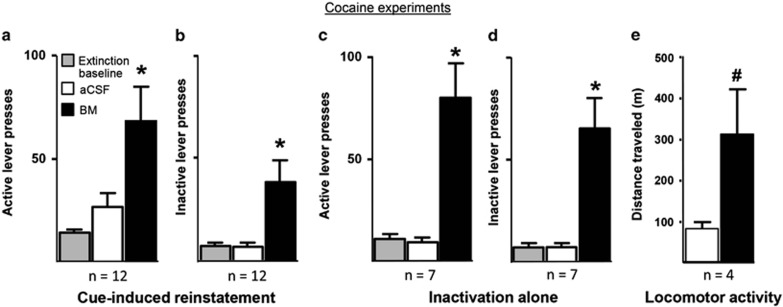Figure 3.
Increased lever-pressing behavior and locomotor activity in rats whose RMTg was inactivated. (a, b) Active and inactive lever presses, respectively, (mean±SEM) during the cue-induced reinstatement session. Post hoc tests revealed that those rats that had received BM microinjections had significantly more active and inactive lever presses during the cue-induced reinstatement test compared with the extinction baseline and those rats that had received aCSF (p<0.01 in all cases). The aCSF group was not significantly different from the extinction baseline, indicating the effectiveness of the prior cue extinction. In addition, a two-way repeated-measures ANOVA was completed based on previous treatment during extinction training (aCSF vs PEPA) and reinstatement treatment (aCSF vs BM). There was no significant effect of prior treatment group (F(1,10)=1.158, p>0.05), a significant effect of drug (BM vs aCSF) given during reinstatement (F(1,10)=10.56, p<0.01), and no significant interaction between previous treatment group and drug treatment during reinstatement (F(1,10)=1.458, p>0.05; data not shown). Thus, prior treatment with PEPA did not affect lever-pressing behavior during cue-induced reinstatement testing. (c, d) Active and inactive lever presses, respectively, (mean±SEM) during a standard extinction session before which rats received intra-RMTg microinjections of either BM or aCSF. Post hoc tests in both cases revealed that those rats that had received BM microinjections had significantly more lever presses compared with the extinction baseline and those rats that had received aCSF (p<0.01 in all cases). In addition, a two-way repeated-measures ANOVA was completed based on previous treatment during extinction training (aCSF vs PEPA) and reinstatement treatment (aCSF vs BM). There was no significant effect of prior treatment group (F(1,5)=0.703, p>0.05), a significant effect of drug (BM vs aCSF) given during reinstatement (F(1,5)=17.48, p<0.01), and no significant interaction between previous treatment group and drug treatment during reinstatement (F(1,5)=0.588, p>0.05; data not shown). Thus, prior treatment with PEPA did not affect lever-pressing behavior during the inactivation-alone testing. (e) Total distance traveled (mean±SEM) during a locomotor activity test. Rats received intra-RMTg microinjections of BM or aCSF immediately before being placed in the locomotor activity test chamber for 2 h. A Mann–Whitney test revealed a significant difference between the two groups (p<0.05). *p<0.01 compared with extinction baseline and the aCSF group. #p<0.05 compared with the aCSF group.

